
Author Archives: Evan Hansen
About Evan Hansen: When not worshiping at the altar of Chambertin, making 6 dozen pierogi with the family recipe, ceaselessly re-mixing a cocktail recipe to perfection, scouring the entire web for the wines of Jean Macle, comparing the merits of sweet vermouths, and taking one extra free taste of cheese at Zingerman's, Evan is a marketing director and creative mercenary.Some Beautiful 2010 Burgundy
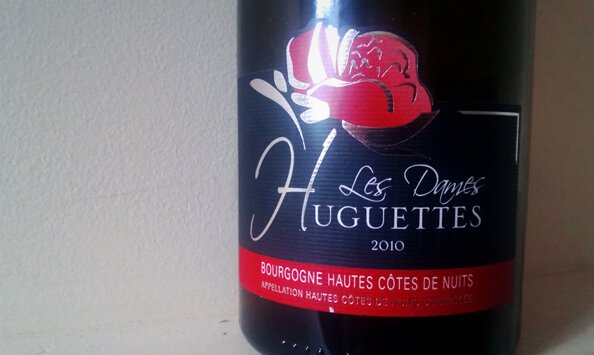
Good burgundy is magical. It occupies more room in my cellar than any other wine, I think about it more than any other wine, and I do genuinely enjoy it more than any other wine. But of course, good burgundy is also really fucking expensive.
Well, most of the time.
Fortunately, Evan Barrett at Plum Market in Bloomfield was recently selling a nice bottle for me to fawn over. From a somewhat unheralded parcel of land called Les Dames Huguettes, this isn’t fancy stuff. The vineyard is from the Hautes Cotes du Nuits, which is a stretch west of northern burgundy known mostly, I believe, for making cheap plonk that ends up on supermarket shelves under the faded, laminated sign that says “FRANCE.”
By contrast, Les Dames Huguettes is, as I understand it, the only chunk of land in the Hautes Cotes for which the name may appear on the label. In other words, the French wine police think it’s not exactly a shitty place to grow grapes for wine. I agree.
This particular bottle is young and juicy, full of fruit. But there’s a lot of acid to it. It’s a very delicious, natural fruit flavor. Incredibly fresh stuff with a nice mineral edge and a finish that lingers. This is seriously delicious. And for around 30 bucks (or so), it’s a very reasonably price for entry level burgundy.
The label struck me as kind of odd and whimsical, so I was surprised by the seriousness of what’s in the bottle. As it so happens, this is produced by Domaine Mongeard-Mugneret, a classic burgundy producer with wines from some of the most sought after grand crus in all of burgundy. So I guess they’re actually slumming it a bit, but hey, good for us.
Those who attended our “Wine Soak” tasting back in April would recognize similarities between the burgundy we tasted there and this bottle. Both from 2010, each wine has the same incredible transparency through the wine to the fruit itself, despite the fact they’re both inexpensive wines. And despite the allegedly less-than-stellar vintage, which was wrought with frost problems leading to dead vines and low yields. But the wines I’ve tasted from that year are spectacular in exactly the same way. I’ve seen plenty of wine critics online indicate that the best winemakers quietly had standout years in 2010 with beautiful, elegant wines, and it’s hard to disagree based on my limited experience.
Anyhow, if there’s any of this left around Michigan, burgundy lovers who aren’t so much blessed with the fat ass pocketbooks should grab some while they can.
Grinding it Out

Already, 2013 has been an impressive year for Corridor Sausage. The artisan sausage company has found a rhythm in their new Eastern Market facility, they’ve launched The Grindhouse food truck, and thanks to USDA approval, they’re about to start selling to retail outlets.
So it seems like this is the time to take the region by storm.
Corridor co-founder Will Branch agrees. “If it isn’t, I probably have a bankruptcy and a divorce in my future,” he says with a hearty laugh. He’s kidding (sort of), but after a long three and a half years of strenuous work, he and partner Zak Alexander seem poised to truly reap the fruits of their labor.
The journey began in 2009 when Branch and Alexander were cooking together at a southeast Michigan restaurant. Neither wanted to open their own eatery, but both were excited at the prospect of something beyond working the line. “If I wasn’t going to law school and I was going to cook, it wasn’t to work for someone else for the rest of my life,” Branch says. “It’s about ‘what am I going to create?'”
Branch had grown up as a routine visitor to metro Detroit’s ethnic butchers, and Alexander had worked on a charcuterie program at Novi-based Steve & Rocky’s prior to their meeting. So the notion of starting a sausage business emerged quickly. “Planning a sausage or charcuterie shop is something every cook or chef talks about at 2am after too much Jameson and Guinness,” Branch jokes.
Wasting little time, they organized a meeting with some potential investors, a restaurant group looking to put a few businesses into a Midtown, Detroit-based development.
“That’s where we started to get attached to the space in the Cass Corridor,” Branch notes. Schoolcraft College generously granted them one-time use of their space and equipment to put together a product tasting, and though it went well and lease negotiations proceeded swiftly, the project eventually stalled. “We branded as Corridor Sausage and thought it was a done deal,” he continues, “And you could say, ‘Oh man, that didn’t come through, we’re bitter about it,’ but we’re not. Those people were all so, so helpful.”
The duo, unfazed, took a flexible approach, looking for any entry point to the marketplace.
They acquired rental space in Howell, got licensed, and started making sausage just seven or eight hours a week. For a full year, they made sausage to order, serving clients like Woodbridge Pub and Jolly Pumpkin. That slow ascent allowed them to perfect their process, eventually making about 500 pounds of sausage in just their eight hour kitchen stint, which opened the door to farmer’s markets.

Jolly Pumpkin’s first order, which they made on Labor Day, 2009, still stands as a memorable moment. They had to produce 250 pounds, and they weren’t yet operational in Howell. So they borrowed restaurant space in Detroit with coolers in the basement, grinders on the fourth floor, and stuffers on the first floor. Branch’s exhaustion is evident in his voice, even years later.
But looking back, he couldn’t be happier. “Pretty much, [the Jolly Pumpkin] order financed our company,” he contends. “Instead of going out of pocket, we had something sitting in our bank account we could parlay into success.” And he still remembers what they put together that day – Vietnamese chicken, lamb merguez, apple and sage pork, and Moroccan lamb with fig.
In summer of 2012, they moved into their new production facility in Eastern Market, a space at the corner of Division and Orleans – perhaps best known to Market goers as the Marry Me Tizzie building. With the new space came new equipment as well, including a vacuum stuffer than apportions the ground meat into their desired quantity. For all its obvious advantages, that brought a series of headaches all its own.
Branch explains: “That first month in the new space sucked. It was awful. It was new equipment, it was an enormous space compared to what we were used to. So everything took longer…. Eight months ago, a fuse blew on our stuffer. Now we know how to fix it and what to look for, but at the time… I didn’t know.” After wading through circuit boards and wires, they got the machine repaired – and now they’re capable of producing thousands of pounds per week.
In outlining that production process, Branch and Alexander humbly reveal the level of quality to which they aspire.
On Mondays, their sole task is preparing the ingredients to mix into the meat – chopping fresh herbs, mincing fresh garlic, weighing spices and figs, and prepping sauces. There are no bagged mixes, no pre-assembled products that go into their sausage. Tuesday, I watched them halve chunks of lamb and unpack ethically raised pork to head into the grinder. After grinding, they mix with their prepped ingredients and stuff into natural casings. And finally, on Wednesday, they package and freeze the meat.
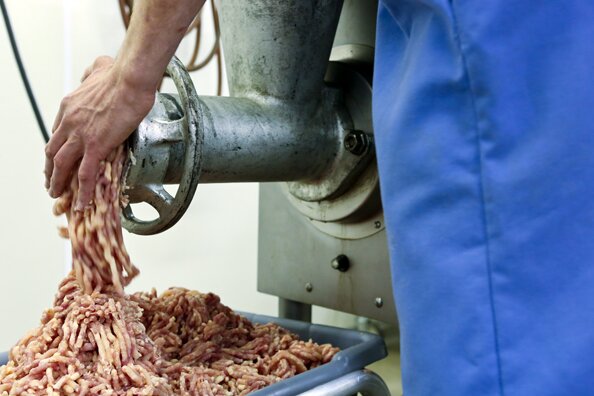
USDA certification represents the next evolution: For Corridor, the rules will preclude any possibility of working with the same protein on the same day. Thus, different meats will get moved to different days of the week, meaning their production schedule must expand. “Right now, we typically make four to six varieties, 600 to 800 pounds [on that Tuesday],” Branch says. “We’ll have to shift our production model to maybe 1,000 to 1,500 pounds in a day, but that’s maybe only two varieties.”
If it seems like a lot of effort, that’s because it is. As finely honed as their process is, it still takes hours of focused effort to achieve. After all this time, Branch still enjoys talking about it. And when I ask what makes his sausage different, he laughs, “It’s the love. The secret ingredient.”
Earnestly, he continues, “No, it’s the quality and the care we put into it. The freshness of the meats. A lot of it is the recipes, the flavor that comes through you won’t get anywhere else.”
Early on, Corridor routinely extended their business to regional catering. Indeed, Branch credits a spike in their initial Eastern Market business to a large event at Cloverleaf Fine Wine in Royal Oak. But as their business has grown, they’ve invested in their food truck – The Grindhouse – and in doing more charity events in town.
“[Last fall], we got to do a catered charity event which may be the thing I was most proud of,” Branch says. “At the Downtown Youth Detroit Boxing Gym, Rock Financial walked into the building with a check for $15,000. Catering has taken a step back to a point where we can do charity stuff.” They continue to work with Dave Mancini of Supino Pizzeria on efforts for the Gym, and last summer, Branch participated in the Next Urban Chef, a program that supports food education initiatives in the city.
While Branch contends they don’t want to overreach, he acknowledges that they’re primed for significant business growth. The USDA label will allow them to sell to local markets as well as take advantage of contacts across the western half of the state and the entire Midwest, building upon existing restaurant clientele in Cleveland and possibly Chicago.
So what comes next? Alexander showed me their new charcuterie cooler, which is in place though not fully built out. Within weeks, they should be hanging salumi and growing their cured meat portfolio. After, Branch says, “the next step will be provisions, like mustards.”
I pressed Branch a bit more about if all the work was worth it and if he’s still genuinely glad that he and Alexander chose to pursue sausage. He chuckled, and offered a sentiment that’s impossible to argue against: “Sausage is delicious. It’s delicious.”

Tasting Notes from the Cellar

There are lots of ways to put together a collection of older wines. Collect and store them in a cellar, buy them from a reputable merchant who has stored them, steal them from a friend, find a store that has found a so-called library release of wines aged at the winery, et cetera. Each of these methods (Except stealing. I think.) were put to use a couple weeks back when a group of us got together to drank some older wines.
A few notes, recorded for posterity’s sake…
1979 Roagna Barbaresco
Delicious from the start, this might have been my favorite wine of the evening, opening up to a beautifully tart and fruity wine with very noticeable spicy and herbal undertones. Tarragon? Mint? Tobacco? Umami? A really nuanced wine that moved from being a bit tannic to downright light and lively. As Todd said, the “most complete wine” of the evening.
1989 Beaucastel, Chateauneuf de Pape
Earthy and big to start, it finished with an edge that smoothed out and opened up over time. A little funk early on that blew off quickly. Lots of fruit, though, even from the onset. Steve observed it might be on the downside of its life. But after a couple of hours, the leather and tannin subsided a bit. Pretty classic; a fine drink.
1999 Antoine Arena, Patrimonio
Dark, deeply colored, full of sediment, brooding aromas to start. Dirty, tannic, earthy wine. Some minerality and acid. Looks brooding, full of flavor, but surprisingly youthful. I wish I’d taken more detailed notes, but the general sentiment was that this was in a good place. Steve observed in retrospect that it was hard to wrap his head around this, and I agree: It was the biggest of the all and came late in a long night of drinking.
1990 Bongran Macon Clesse
 Remarkably unique. Truly. Drew a chorus of quizzical looks and comments. Todd described the aromatics as being a lot like coffee beans, and Putnam began to latch onto that as a descriptor for the flavor as well. I think I see what they were getting at in terms of a the long, slow, earthy quality of the fruit. Floral and honey notes. Not sweet but clearly botrytized grapes. Lots of tropical fruit but not of the predictable sort found in so many overly engineered wines. Some in the group felt it would be hard to drink this in any serious quantities, me among them, but it’s hard to deny its brilliance.
Remarkably unique. Truly. Drew a chorus of quizzical looks and comments. Todd described the aromatics as being a lot like coffee beans, and Putnam began to latch onto that as a descriptor for the flavor as well. I think I see what they were getting at in terms of a the long, slow, earthy quality of the fruit. Floral and honey notes. Not sweet but clearly botrytized grapes. Lots of tropical fruit but not of the predictable sort found in so many overly engineered wines. Some in the group felt it would be hard to drink this in any serious quantities, me among them, but it’s hard to deny its brilliance.
1996 Dugat-Py Bourgogne Rouge
I wonder what this cost on release. No famed crus on the label. Just good wine in the bottle that has lasted until now. Light, refreshing, but still structured. As Putt said, it’s “chuggable.” Of course, Putt thinks whiskey is “chuggable.” But still, I tend to agree. We also had a 1995 Marechal Pommard, and the Dugat-Py was in a far better place. The other was gnarled and dare I say backward whereas this was simply pretty.
1999 Juge Cuvee C Cornas
Coming after a puckeringly tart Morgon and even the Chateauneuf, this was downright jammy. Young and fruity. A nice dose of acid, but compared to other wines, this really seemed sweet. Delicious but didn’t really suck me in the way some others did.
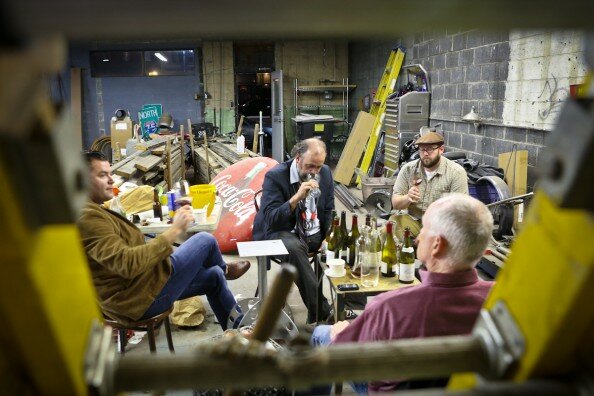
Slideshow: The Next Urban Chef
Chef Andy Hollyday wandered out from behind his burners to check on our table, “How was everything?” We all nodded, our mouths full of food, and mumbled our appreciation. It’s a scene I’d witnessed several times, the chef taking a few moments to check in with his customers. Except generally, I’m seated at Roast, and Andy’s cooks are typically old enough to grab a beer after work.
Last Saturday, though, it was an entirely different setting: Andy’s kitchen was a range and a few tables in the corner of Eastern Market’s Shed 5, and his team consisted of a handful of local students participating in The Next Urban Chef, a food system education project put together by Detroiter Alison Heeres.
Hollyday joined Corrdor Sausage’s Will Branch, The Sunday Dinner Company’s Eric Giles, and Supino’s Dave Mancini as team leaders, about a dozen students learning and working under their guidance to learn about food, local agriculture, and teamwork.

The competition was judged, with each team preparing three dishes and their subsequent scores being allocated based not just on the food but on their ability to work together and their use of Michigan ingredients.
Hollyday’s team, which won the competition, besting reigning champ Dave Mancini, prepared sweet corn ravioli with shrimp, roasted chicken with an apple cider vinegar sauce and Swiss chard, and an apple rosemary tart with homemade vanilla ice cream. I’m fortunate enough to say that I tried all three courses, and Chef Andy and his students did a great job.
To learn more and be privy to info about next year’s event, check out their Facebook page.
Pizza Catharsis

It’s been a long week. First, I was up working until 1am three days in a row, which sucked pretty hard. Second, I partied pretty late on Friday. And third, I woke up Saturday morning only to pay witness to a television commercial advertising a wireless cable box that lets people watch their TVs on the patio and in the kitchen and presumably on the crapper. Wireless cable boxes. A notion so grotesque that it made me vomit all over the place.
Well, not really. But I nevertheless needed to get some relaxation. Since my personal masseuse has Saturdays off, I opted to occupy my day of repose with cooking. I had a bunch of tomatoes, a ball of fresh mozzarella, and some lamb merguez sausage from Corridor Sausage sitting around, so en route to Eastern Market that morning I decided to make pizza.
For the past two weeks, I’ve been visiting the Grown in Detroit stand, acquainting myself with papalo, an herb that apparently grows wild across Mexico and some of the southwest United States. It’s not quite as concentrated as cilantro or basil, but it nonetheless packs an awful lot of flavor in a single leaf, simultaneously bright, earthy, and green. The plants can get as tall as 6 feet in prime conditions, and the leaves themselves are about 1 or 2 inches across. The Wikipedia page says it’s also popularly known as Bolivian Coriander. And in its native Mexico, it’s ostensibly served similarly to cilantro, as a fresh herb to accent pork tacos or spicy sandwiches.
I had put it on sandwiches and in eggs last week, so last night, I opted to throw it on a pizza. But not, like, literally throwing or anything. Because that mess would have made a shit hole out of my kitchen.

With onion, papalo, cheese, and sausage in hand (If you’re so moved by the phrase “sausage in hand,” please stop reading, snicker, and take a breath before moving on. No one’s judging.), I moved on to consider an appreciate sauce for my burgeoning pie. Given the Latin-inspired flavors in the meat, I briefly flirted with the idea of a BBQ sauce-based pizza. I definitely like a well-made BBQ chicken pizza as much as the next dude, but I knew wanted to write a blog post so I could mention the papalo. And if I used something as cliche as BBQ sauce for a southwest-style pizza and then wrote about it, I’d have to hurl myself into traffic.
So instead, I threw some tomatoes and a red bell pepper on the grill and charred the living shit out of them, setting them aside as the base of my sauce (more on that later). As I’d hoped, the char gave it more depth than it might have had otherwise.
I mixed together some pizza dough from Peter Reinhart’s Artisan Breads Every Day, a blend of 50% bread flour and 50% whole wheat flour, assembled most of my pie, and slid that shit onto my blazing hot pizza stone in an oven that’d been sitting at 475 degrees. After 4 minutes, I rotated it, added the papalo (I often add leafy toppings a bit late in the process so they don’t get burnt ), and then finished it up.
The results?
Pretty damn good, I’d say. I didn’t get the crust totally perfect, but it was my first time with that particular recipe. And the toppings were totally killer: As always, the products from Corridor Sausage are delicious, the papalo worked out really well, and so on. Nothing revolutionary by any stretch but tasty to be sure.
Should you want to make something similar in the future, I’d recommend starting with the sauce because (a) it’ll be a big ego boost for me personally and (b) it tasted pretty damn good.
To begin, get a single red bell pepper and enough tomatoes to make a couple overflowing handfuls once chopped. Before you go cutting on things, fire up your grill, put the tomatoes and the pepper on it, and cook until the pepper is nice and charred and the tomatoes are soft but not falling apart, kind of like a teenage girl watching Sleepless in Seattle for the first time ever. Skin the pepper entirely and skin most of the tomatoes, leaving some blackened yumminess in the mix.
Then chop them until you’ve basically made a pile of goo. Cook about a quarter of a small onion, minced, and some garlic, also minced, in your sauce pan using some olive oil. Add the tomato goo at the appropriate time, throw in a bay leaf, add maybe a teaspoon or so of vinegar to your liking, add a bit of salt and pepper, and then heat until it has the consistency of a tomato sauce. If you don’t know what any tomato sauce looks like, how the hell have you read this far? Just stop now.
Taste the sauce at this point, removing the bay leaf and being absolutely certain to not to scald your tongue like a buffoon. I rather enjoyed it on the tart side, but I still added a bit of sugar, stirring it in until it dissolved. I cooled it then used it on the pizza few hours later. I had barely any left, so consider this a single serving recipe.
Also, check out the papalo at Grown in Detroit if it’s still around for the next couple of weeks. I’ve enjoyed playing with it quite a bit and the flavor, while not notably powerful, lingers on your palate for a long time.
* * * * *
And in conclusion, I leave you with this pizza making tutorial and a friendly reminder that when you put stuff on the internet, people will find it and may laugh at you.
Domaine Abbatucci
 During dinner with some friends on my patio last night, I opened a bottle of Corsican wine about which I knew next to nothing. It really illustrates one of the things I love about wine, which is that there’s always something new to learn. Whether it be a comparative tasting of different vintages or chemistry or culture or tracing the lineages of grapes, the dive into a wine’s origins can be an absolutely endless journey.
During dinner with some friends on my patio last night, I opened a bottle of Corsican wine about which I knew next to nothing. It really illustrates one of the things I love about wine, which is that there’s always something new to learn. Whether it be a comparative tasting of different vintages or chemistry or culture or tracing the lineages of grapes, the dive into a wine’s origins can be an absolutely endless journey.
Cuvée Collection “Diplomate d’Empire, Il Cavalière” from Domaine Abbatucci not only occupied a portion of the conversation last night, it has occupied my entire morning. Composed of 37% Vermentinu, 20% Rossala Bianca, 19% Biancu Gentile, 14% Genovese, and 10% Brustiano (from the Kermit Lynch website), the cepage was so foreign to me that I’ve been obsessing about figuring out what the hell all of these grapes actually are.
The wine itself was remarkably dense and rich: Very floral, fleshy nose with melon/white fruit aromas. Sweet on the palate, but not flabby at all. I tasted the fruit first and foremost, but there’s an inherent mineral-driven acidity/structure to it. Viscous and oily texture, it’s got a very serious weight to it and a finish that lingers. It’s really very interesting, luscious stuff. Very distinct and dare I even say unique. I wish I’d gotten a second bottle, because for all of its loveliness, I felt like it had more to offer had I given it a bit more time to breathe.
After having my mind blown, I decided to investigate the winery and those odd grapes a bit.
First, the winemaker has a fascinating history. His father is responsible for saving tons of native Corsican grapes, and they’re directly descended from Napoleon Bonaparte. This Cuvée Collection set of wines are all named after people who were involved in Napoleon’s life: So the Diplomate in question is actually a childhood friend of Napoleon who fought with him at the Battle of Waterloo. The details are outlined on Lynch’s website.
The grapes are equally interesting. Having compared the importer’s notes and the Domaine’s own website, I realized that while Lynch was listing the Corsican names for the grapes, they’re far more commonly known by their Italian names (or the synonymous French names). Vermantinu was obviously Vermantino, prized for its aromatic qualities. Rossala Bianca is, in Italy, Rossola Bianca, and according to a book by Oz Clarke, it’s synonymous with Ugni Blanc from France, most notable for its use in making cognac (where grapes that yield high acid are prized for the flavors it yields through distillation). Of course, Ugni Blanc is also, I believe, know as Trebbiano in Italy. Say what?
So the morning got off to a start that was, to put it bluntly, confusing as fuck.
I kept digging, though, and I could find nothing on Bianco Gentile except some references to other Corsican wines where it was consistently referred to as one of the “lost” varieties that’s recently been reclaimed. As I mentioned earlier, it’s the Abbatucci winemaker’s father who took it upon himself to wander the Corsican countryside and preserve grapes like Bianco Gentile from what would have otherwise been extinction in the 1960s.
I couldn’t find much on Genovese other than some references to a “Bianchetta Genovese,” which is ostensibly a non-descript Italian grape called Albarola according to Wikipedia and a few blogs. The subtle distinctions aren’t really all that important, I suppose, but while it’s known for its plantings in northern Italy, this Albarola simply must be at least a little different in Corsica (assuming its even related). The evolution of distinct ecosystems and how that impacts the resulting grapes is every bit as interesting to me as the food and cultural components to how a particular wine has evolved over time.
Similarly, do a Google search on the last grape, Brustiano, and about a million websites will tell you that it’s synonymous with Vermantino, but clearly the winemaker finds something different since he lists both Vermantino and Brustiano as components to his wine.
Regardless, this combination of mostly soft, semi-sweet grapes and Ugni Blanc created a drink that’s quite profound. Naturally, it’s available in limited quantities. The winemaker makes a number of wines, but the “Cuvée Collection” series are all from a single plot of these heirloom, indigenous grape varieties, farmed biodynamically (down to the weird ass moon cycle rituals) with low yields, and so on.
So its rarity and relatively lofty price tag are easy to understand.
This bottle was recommended to me by Elie Boudt at Elie Wine Company in Royal Oak. There are only two cases, so if you’re interested, get there soon. I drank it along side grilled halibut and veggies as well as a wheat berry salad with a distinctly provençal twist. Pretty much perfect.
Chicago Road Trip
 In spring 2012, my alma mater, the College of Literature, Science, and the Arts (LSA) at the University of Michigan, printed two pieces I wrote after interviewing Chicago chefs and U-M alumni Rick Bayless and Stephanie Izard. They’re both being re-published here with permission of LSA Magazine.
In spring 2012, my alma mater, the College of Literature, Science, and the Arts (LSA) at the University of Michigan, printed two pieces I wrote after interviewing Chicago chefs and U-M alumni Rick Bayless and Stephanie Izard. They’re both being re-published here with permission of LSA Magazine.
If you have but one day in Chicago this summer, I can think of no finer way to spend it than lunching at Bayless’ XOCO and having dinner at Izard’s Girl and the Goat.
* * * * *
After graduating from the College of LSA, chef Rick Bayless spent years in Mexico studying the language, the people, the food. The knowledge he brought back to the United States helped change the landscape of cuisine as we know it. The linguistics major-turned-culinary-giant gave us a seat at the table to discuss his salad days – then and now.
Chef Rick Bayless (’75, M.A.) is every bit as infatuated with Mexican cuisine today as he was in 1987 when he opened Frontera Grill in Chicago and released his first book, Authentic Mexican: Regional Cooking from the Heart of Mexico. “I can look at something I discovered 30 years ago and understand it now in such an intimate way that I could never have done at the very beginning,” he says. “That sense of deepening discovery is what keeps me going every day.”
A recent winner of Bravo’s television program Top Chef: Masters and an unquestioned legend of Chicago’s now vibrant food scene, Bayless is as big a celebrity chef as anyone in the United States. It’s hard to imagine North Clark Street without his trio of restaurants or store shelves without his salsas, but he didn’t begin his career looking to be famous. Or even to cook.
“I was really interested in the relationship between language and culture,” he says of his college years spent studying Spanish and Latin American culture. After living in Mexico with his family as a teenager, Bayless became an undergraduate at the University of Oklahoma. He spent two summers in an applied linguistics program and learned how to enter communities that lacked a written language, learn and interpret their spoken words, and ultimately understand that culture through their stories.
He followed the program’s director to LSA’s Department of Linguistics, where he began several years of doctoral work. But he found more than just scholarly interests awaiting him in Ann Arbor.
“I fell in with this group of students… we didn’t have any money at all, but we were all super into food,” Bayless recalls. “I didn’t even understand how unique the food community of Ann Arbor was then, but it was centered around the farmers’ market.” He and his friends would buy their fresh ingredients in Kerrytown and at Eastern Market in Detroit, meeting and interacting with farmers, a practice reminiscent of the everyday life he’d experienced in Mexico.
These linguistics students prepared food together regularly, exploring different cuisines from a myriad of cultures. Bayless started catering. He taught local cooking classes. Then he had an epiphany: “I was at least as interested in the relationship between culture and food as I was culture and language.”
That’s when the future James Beard National Chef of the Year stopped work on his dissertation and immersed himself in the food of Mexico.
Throughout the early 1980s, Bayless lived and traveled in Mexico with his wife, Deann Bayless (’71, ’78 M.U.S.), utilizing his academic experience to construct Authentic Mexican. Each recipe was studied using the same research methodology he learned at Michigan: He prepared each dish with three different families or cooks to grasp every nuance, every approach, every ingredient. The result was more than a cookbook; it became a comprehensive look at the cuisine of Mexico as an expression of regional culture as well as an influential guide to a burgeoning American food scene that was slowly awakening from a decade or two of hibernation.

Upon returning to the United States, Bayless found himself in the midst of a dormant food culture dominated by commoditized products and corporate wholesalers – a stark contrast to his childhood.
“I’m a child of the ’60s. I made my first compost pile when I was 16. I made salt-rising bread,” he recalls. “I went with my father to the market in Oklahoma City… and the farmers would bring their stuff and we’d buy from the farmers,” Bayless remembers. “And then, that all went away and it just went to a commercial commodity market. We never had face-to-face contact with the people who were growing our food anymore. And I had a sense of loss about that.”
A do-it-yourselfer raised in a family of restaurateurs living amongst small farmers in Oklahoma, he couldn’t abide the lack of local food he found as he began his culinary career.
So Bayless set out to do things differently. He describes his first experience as a chef engaging Chicago-area farmers: “One of the things I wanted to do was put something local on our menu…. We opened in March, and May is when we have our short, local strawberry season… so I went down to the commercial market…. And they all said, ‘No one would carry those. They’re terrible.’ Well, they’re terrible only if you’re thinking of them as a commodity. They’re phenomenal if you’re thinking of them as flavor.”
Literally laughed out of the market by wholesalers, Rick and Deann drove twice per week to farmer stands outside the city to acquire those local berries for desserts. Beyond the superior flavor, the chef regained a connection to farmers in a way he hadn’t experienced since childhood. And he became increasingly grateful for it.
When Bayless talks about food, he looks and sounds as much like a professor of art history as he does a master of the culinary arts. His conference room at Frontera doubles as a library, its 10-foot walls lined with volumes on every conceivable culinary topic, ranging from French sauces to chocolate to Mexican culture to gardening. And, indeed, he broaches the subject of food as any intellectual might – that is, from every conceivable angle: flavor, art, community engagement, eco-friendliness.
Thus it’s perhaps unsurprising that his consistently calm demeanor elevates to a passionate tone when discussing the interrelated nature of his customers, his farmers, and his food.
“I have always seen restaurants – and I guess it’s because I grew up in a family-style restaurant—as creating community,” he says in describing his family’s approach to business. Along with those childhood trips meeting farmers, the notion of community has shaped his work.
“I’m an accidental organic farming champion,” he notes. “What I learned was that the people that cared most about what they were growing also cared most about the earth…. [Farmers] taught me about the interconnectedness of what I do as a living.” His holistic view of soil’s role in the food he serves his customers has led him to value sustainability. “If it’s local and sustainable, it’s part of that sense of community. It’s not just in putting money in the pocket of the farmer, but it’s protecting our environment that allows us all to thrive.”
Committed past the point of mere rhetoric or marketing, Bayless has maintained a laser-like focus: 25 years since he first ferreted out local strawberries, he has continued to push the boundaries of how local, sustainable food can be used. “The thing about food is that the more you’re around it, the deeper you can go,” he says.
During the late summer, 100 percent of his tomatoes and tomatillos are Chicago-raised. Even Tortas Frontera, his O’Hare Airport-based eatery, lists from where the food is sourced. His Frontera Farmer Foundation raised $180,000 last summer in support of local farms, and he’s a board member at the local Green City Market, the lone Chicago-area market dedicated solely to local, sustainable foods.
“With the strength of our local agricultural system, our food is different, and it allows a uniquely Chicago perspective on traditional Mexican flavor,” he says. So he strives to employ it often, noting that what he serves isn’t always what one might find in Oaxaca or the Yucatan. Rather, he asks himself, “How do you get local flavor on the plate without messing with the traditional soul that you find in Mexican kitchens?”
Bayless grows some of those Mexican-inspired ingredients on Frontera’s eco-friendly rooftop garden and at his own home. The only common ingredient that doesn’t occasionally come from Chicago-area farmers is dried chiles because, as he says, “the flavors just can’t be duplicated, and… we’re into making delicious food.”
In contrast to the many celebrity chefs leaving their hometowns, opening restaurants in Vegas or eating strange foods on cable television for shock value, Bayless’ three primary restaurants and offices are on a single block, and he’s entering the eighth season of Mexico – One Plate at a Time, airing locally in Chicago or on various PBS stations and often costarring his daughter.
When he does leave Chicago, it’s usually to visit other countries to study new cuisine and other cultures, and to enhance the culinary creativity on display at his restaurants.
“You can learn things that reflect back into your food, other techniques, and other ingredients that will open your mind to different flavor possibilities,” he observes. “Anything is open to us as long as it has the spirit of the Mexican kitchen.”
* * * * *
Chef Stephanie Izard has won Top Chef, not to mention a host of awards for her new Chicago restaurant, Girl and the Goat, but her food is neither haughty nor highbrow. Izard studies “common food” and elevates it, with a culinary result that’s like Izard herself – genuine and clever.

Soaked in syrupy lemon dressing, Chef Stephanie Izard’s eggplant is an eyeopening revelation. Eye-opening because it is a dessert; a revelation because it is the perfect acidic counterpoint to other elements on my plate: pork-fat doughnuts, ham streusel, caramelized figs, and a honey yogurt. Soft, crunchy, fatty, sweet, salty, and tart – it is an embodiment of Izard’s “make your whole mouth happy” philosophy.
The meals she prepares under that banner have garnered her and Girl and the Goat – the Chicago restaurant she opened in 2010 – national acclaim. Izard was a celebrity already, having won season four of Bravo’s wildly popular Top Chef, but it’s her work since, as chef and co-owner at the Goat, that have catapulted her to true stardom. Capturing rave reviews from the Chicago Tribune and Saveur magazine as well as a prestigious James Beard nomination, she was named a Food and Wine Best New Chef in 2011.
“If you could see me when I was on stage getting my award for that in New York, I had a gigantic perma-grin the entire time,” she recalls.
That’s hardly surprising: Izard’s a veritable ball of energy, talking fast, laughing a lot, and infusing every inch of her sizeable restaurant with every ounce of her sizeable persona. “I just wanted to take what I love about dining – which is hanging out with friends, usually quite a few drinks—and that’s why this place has a party vibe. Big fun with lots of energy.”
The space fosters that attitude with ample seating and high ceilings that echo with hundreds of voices, and a soundtrack that ranges from Johnny Cash to the Red Hot Chili Peppers to Regina Spektor. The bar is packed with tourists and regulars alike, and the atmosphere spawns conversation from the moment the front door opens.
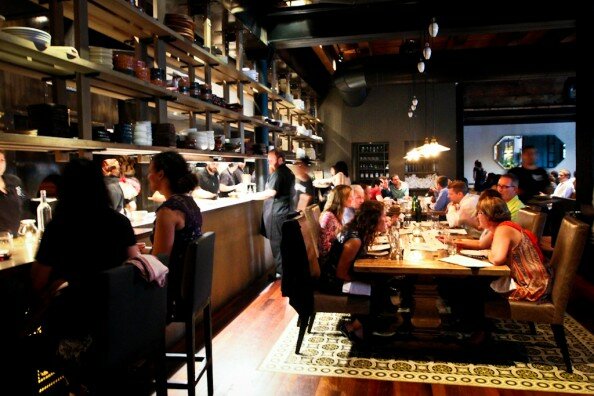
Seated at the far end of that very bar, I was quickly befriended by a 40-something professional Chicagoan awaiting some friends. Within 45 minutes, I was sharing my cauliflower with pickled peppers and mint – portions at Girl and the Goat are naturally designed for sharing with friends both old and new – and she was sharing her goat chorizo flatbread.
The shareable, approachable food is just as driven by Izard’s demeanor as the palpable friendliness imbued throughout the dining room. Signature dishes like roasted pig face, a dramatically more interesting variation on traditional head cheese, elevate comfort food and ostensibly simple ingredients to haute cuisine, without even a hint of the snobbery that sometimes pervades the restaurant world.
“I’ve been lucky and have eaten at some amazing restaurants,” says Izard, “and I enjoy it, but I don’t enjoy the stuffiness of it.I just don’t think one has to come hand in hand with the other.” She adds, “I’ve definitely always been anti-pretense.”
That attitude is exemplified in her thorough, hands-on approach. Izard doesn’t just prepare a meal; she studies each component of it. Before opening the Goat, she took the time to visit local farms, getting to know the farmers and learning everything from how the animals are treated to how goat cheese is made. “Now [the farmers are] my friends. I call them up, we hang out,” she says. Izard contracts with farms “where we liked the farmers themselves and respect what they’re doing. We only get animals from farms where we know they’re raised properly.”
Her commitment to that depth of understanding extends to every aspect of the restaurant, which includes having an inhouse baker and butcher. She’s explored an interest in beer (the lone piece of art in the restaurant features a girl, a goat, and dancing beer bottles) by visiting Indiana’s Three Floyds Brewing and by actually making beer with Chicago-based Goose Island. “I’ve gotten to brew beer a couple times. I don’t think it’s anything I could do by myself, but it’s really cool to know more about it. And we make our own wine in Walla Walla (Washington). We make our own cheese. I just kind of want to learn how to do everything.”
Izard’s curiosity about food began early at her childhood home in Connecticut, where her parents enjoyed a wide range of cuisine. She earned a sociology degree from LSA in 1998, and if there were any hint at her future, it lay in evenings out with friends.”We would go through and order all these different beers, and I remember [learning] about it and thinking, “this is cool.'”
After graduation, she enrolled in Le Cordon Bleu in Arizona, where she learned the skills that later took her to several acclaimed Chicago establishments before opening her first restaurant, Scylla, in 2006. Despite rave reviews, she opted to close in 2008, not long after which she joined Top Chef. The prize money helped pave the way to her current endeavor.
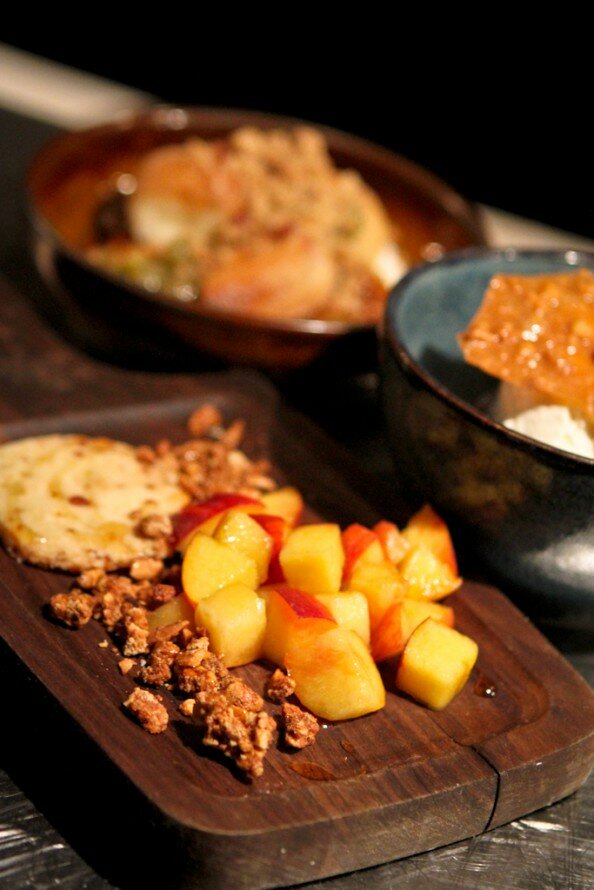 From day one, Izard has insisted on staff sharing her excitement for their ingredients, drinks, and food.
From day one, Izard has insisted on staff sharing her excitement for their ingredients, drinks, and food.
“We interviewed over 1,000 people,” she says, “and we’ve interviewed people who worked at some of the best restaurants in the city, and I’m like ‘yeah, you’re a great server, but still, you’re not getting it. You need to have the enthusiasm, and you need to want to make someone feel comfortable as soon as they walk in the door.'”
Izard’s a master at lending that sense of comfort to her patrons: Sitting at the bar, looking toward the kitchen, I could see fans approaching her to say hi or take pictures, which often end up on the restaurant’s website. She’s become widely known for being one of the most sociable “celebrity chefs” in the country, someone who hasn’t changed as a result of her fame.”Even if I’m sick at the store and a fan comes up, I’m still going to talk to them. [Some chefs] get annoyed by people… but someone coming up to you and saying they love you? I mean, that’s pretty nice. Be happy about it.”
That connection with her devotees achieved new heights last summer when Izard launched a fundraiser for Share Our Strength, an organization fighting childhood hunger: “We’re doing these benefit dinners called Supper at Steph’s where I invite eight strangers into my house and cook dinner for them, and my staff said, ‘Seriously, Stephanie, what if they look through your underwear drawer?’ And I’m like, well, they’ll look through my underwear drawer. I don’t care.”
She’s laughing as a cook brings her a spoon covered in ginger dressing destined for the crunchy raw kohlrabi salad. “As long as I’m not in the bathroom, they’re supposed to bring me a taste.”
Izard’s well-known for carrying her upbeat persona and positive demeanor into the kitchen, a place notorious for hot tempers and demeaning attitudes. “I think that my cooks genuinely enjoy coming to work. Of course, they’re often hungover and tired and don’t really want to get here in the morning. But we have fun. We sing and dance all day. Having someone yell at me doesn’t make me want to work harder for them, it makes me want to have them not be around anymore.”
That’s not idle talk. The restaurant’s open kitchen allows patrons to peer inside. “You can see all the cooks smiling and enjoying each other’s company, which I just think is so important. If you’re putting out food that’s supposed to have all this love in it and you’re pissed off, it’s probably not going to taste as good.”
Her cooks must have an awful lot of love, because the lengthy menu is delicious from top to bottom. In her inimitable style, she doesn’t overthink it. “If I try too hard to make new menu items – like, all right, I must make a new fish dish this week, then it never works. So for me, it’s waiting to see if something just hits and something clicks. Like if I walk in the cooler and see some vegetable next to another one, and I’m like, ‘Yeah!'” That revelation explains her cross-cultural influences – for example, Izard’s crudo, an Italian-inspired raw fish dish, puts buttery Pacific hiramasa under bits of pork belly, Peruvian chiles, and caperberries.
That culinary creativity is showcased in Girl in the Kitchen, a book of recipes from her home kitchen released last October. She toured all winter to support the cookbook, while simultaneously planning her version of a classic diner, which she’s calling The Little Goat. She’s constantly busy, but she admits that’s how she likes it. “I’ve always been really driven and want to be as successful as possible. And I’m hoping to retire in 10 years, so I’ve got a lot to do.”

Breaking News: Elitism Runs Rampant in Cocktail Bars!
We’re under siege, folks. Less than a year after the first dedicated cocktail bar opened in the metro Detroit area, elitism and ego-maniacal bartenders are ruining the spirit of the bar. Gone are the good old days of showing up to a bar, having a nice chat, and paying for whiskey with that lone dollar bill you had crammed into your pack of smokes.
Or at least, that’s what Christine Sismondo of Huffington Post is claiming.
I recognize that linking back to their post is exactly what they’re after with these types of trolls, but (a) our tiny ass website isn’t going to make much a difference one way or the other and (b) I hate the obnoxious practice of requiring a login from Facebook or Twitter in order to respond, so I’m going to write up my response (some uneducated folks might call it a “rant” or something) right here instead.
In comparison with cork-sniffing and vintage-cataloguing, quaffing cocktails seemed a lot more fun — and a whole lot less like work. That was 10 years ago, an era when cranberry juice reigned behind the bar, insisting on fresh citrus was considered crazy and the shaken martini was still de rigeur.
I find claims of sweeping elitism from those who, unlike those of us in and around Detroit, have had seemingly regular access to craft cocktails for a decade to be more than a little disingenuous. I wonder if the author went back to drinking nothing but Jack with sour mix and G&Ts for 5 years if she’d feel the same way.
After she gives us quick history of the resurgence of craft cocktails, we get this gem:
As bartenders are downright fetishized for their ability to combine specific spirits, I feel we’re losing some of the spirit of the bar. People are there to have a good time and meet people, not to pray at the altar of the cocktail.
OK, actually, I agree. After all, every moment of every day is all about ME, and the last thing I should do is go out to enjoy something interesting that someone else worked hard to make. Deriving pleasure from eating and drinking the result of someone else’s time and effort is so yesterday. Who cares if it’s a unique drink that I can’t make it at home? Pass the Blueberry Stoli.
Also, I find that I dine out just to fill up and chat with my friends, not to derive any real satisfaction from what I’m eating. I’m not there “to pray at the altar” of the chef, so I’m just going to patronize McDonald’s from now on. Why deal with pretentious servers talking about farmers and shit when I can just have a seat in an uncomfortable plastic booth and shovel food in my face while eking out a little conversation betwixt huge bites?
There are other aspects of fine drinking (as opposed to fine dining) that are less than democratic. Craft cocktail bars aren’t your drop-by-after-work-and-chat-with-Norm kind of places.
Uh, really? In every city I’ve ever been, I’ve made decent pals with the bartenders at the cocktail bars I’ve gone to. And here in Detroit, anyone who thinks Dave, Chuck, Yani, Lucy, John, and Rick at the Sugar House and Sandy, Adrianne, and Jackie from the Oakland aren’t friendly are crazy.
Also, while it is true that I do not in fact know anyone named Norm with whom I can chat at either of those bars (or any of the other bars in Michigan for that matter), I do see someone I know every time I go to them. Granted, most of my friends are lushes, and this isn’t New York with its 800 million people, but whatever.
Why are we trying to de-socialize the emblem of sociability? And then there’s the price. It’s not unusual for a cocktail to run between $12 and $16 these days.
Sounds like she lives in a crappy place with crappy bars. Move to another city, crazy lady. Par example, as the French would say, Detroit’s tres cool, as the French would also say.
Then after you move to Detroit, if you don’t want an elitist bowl of sea urchin foam layered atop gold-infused gin, just order an Old Fashioned at the Sugar House, which is made well and will cost you five whole dollars. Come to think of it, is there a bar in your city where they are forcibly dumping cinnamon bitters and egg whites down customers’ throats and charging 20 bucks? Because that actually would be a problem worth writing about in HuffPo.
But just in case elitism is even a small component, I’m doing my part to fight it — I’m switching back to wine. And the occasional vodka.
Thank goodness! Because first growth Bordeaux and Grey Goose have absolutely no problem with snobbery or exclusivity among those who serve or drink it. Keep on fighting the good fight!
Meanwhile, I’m going to thank my lucky stars that we’re no longer part of the era where our choices were basically a vodka and cran or a Bud Light. If that’s our alternative, I’ll relish a little elitism in my life.
Real or Fake? Marketing with Blogs
We get a lot of marketing-related emails from people who basically want to pay us to write about their product or who want to give us free samples to say nice things. That’s a perfectly fine way to make a living, but it’s not what we do.
Still, since those emails generally involve a lot of self-aggrandizing, they’re often worth a chuckle or two. What follows may be a real email, or it may be us parodying an email.
What do you think of the text below: Real or Fake?
Todd,
More info below but Mako Vodka, a new vodka to the Detroit area, has a slew of beach-themed cocktails that I thought could work for a Memorial Day cocktail piece. I have drink images to go along with these and can send along a sample of Mako (it recently won a Gold Medal from the Beverage Testing Institute).
I know there are a 101 vodkas out there, but Mako is less about the crazy flavors and more about a mindset. The brand, which is named after the Mako Shark, is trying to cut through the clutter by reaching out to those who are into the nautical lifestyle whether that is boating, sailing, deep sea fishing, etc.
If Memorial Day weekend doesn’t work, there’s always Shark Week (everyone’s favorite cocktail occasion, maybe not quite yet, but it should be), Shark Week airs in July.
Thanks,
Courtney
Fun facts about the Mako Shark:
- Fastest shark in the water. A Mako can swim up to 60 mph when on the hunt.
- Nickname: “The Cheetah of the Sea.”
- Extremely adaptable. Can live in warm, cold, shallow or deep water.
- Slightly famous. The Short Fin Mako was featured in Hemingway’s “Old Man and the Sea.”
- Cool trick. A Mako will leap out of the water. Scientists are befuddled at why they do this. We think they want to check out the scene.
Fun Facts about Mako Vodka:
- The Mako shark may like all types of water, but Mako Vodka uses only pure natural iron-free limestone spring water.
- At 75ft, our stills are about the size of 8 Mako sharks lined up from head to fin. Mako Vodka is five-times distilled for exceptional purity.
- We add oven-dried, medium-roasted malted barley to our mash bill. Sure a Mako shark wouldn’t go for barley, but our fans love the taste.
- We’re also slightly famous. Mako Vodka was awarded a 93 rating, gold medal from the Beverage Testing Institute.
Summer Cocktails
Mako® Shark-in-the-Water Martini
1 part Mako Vodka
1/2 part Blue Curacao
1 part Sweet & Sour (or Fresh Lemon Juice)
Splash Cranberry Juice
Combine in a shaker with ice. Shake and strain. Garnish with lime wedge.
Mako® Raspberry Sharkbite Martini
1 part Mako Vodka
1 part Chambord Black Raspberry Liqueur
1 part Sweet & Sour (or Fresh Lemon Juice)
Combine in a shaker with ice. Shake and strain. Garnish with lime wedge.
Mako® Blue Ocean
1 part Mako Vodka
1 part Blue Curacao
1 part Pineapple Juice
1 part Cranberry Juice
Combine in a glass with ice and stir. Garnish with lime wedge.
Mako® Harborside Chiller
1 part Mako Vodka
1 part Peach Schnapps
1 part Lemonade (or Sweet & Sour)
1 part Cranberry Juice
Splash Club Soda (optional)
Combine in a glass with ice. Top with Club Soda, if desired. Garnish with lime wedge.

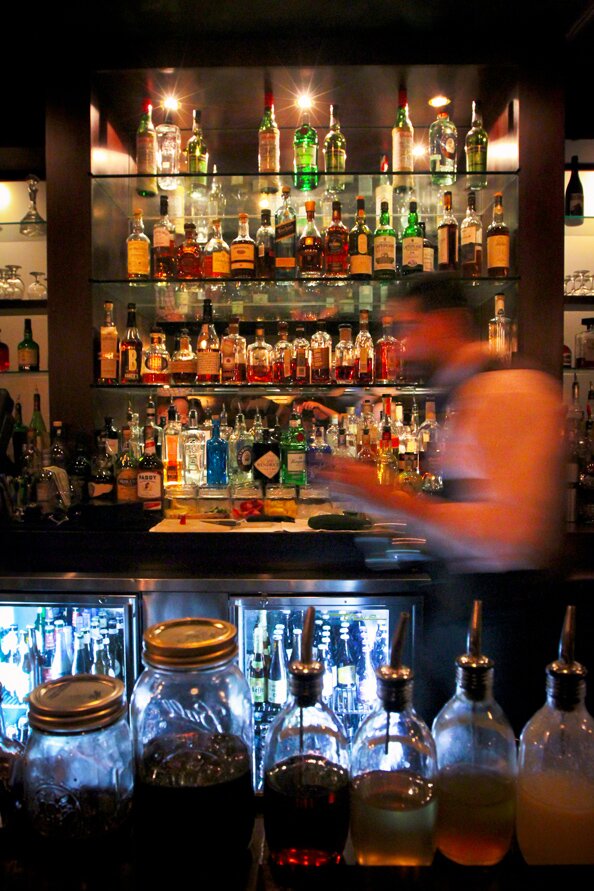 Eventually, they’re hoping to employ a seasonal approach to the menu, changing drinks more frequently and exposing people to more options and more ideas. For the time being, they’re taking their role as educators seriously. Between shaking drinks, Aversa chimes in, “We do a lot of talking with our guests, a lot of brainpicking. Asking people what they’ve had before.”
Eventually, they’re hoping to employ a seasonal approach to the menu, changing drinks more frequently and exposing people to more options and more ideas. For the time being, they’re taking their role as educators seriously. Between shaking drinks, Aversa chimes in, “We do a lot of talking with our guests, a lot of brainpicking. Asking people what they’ve had before.”